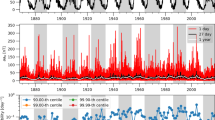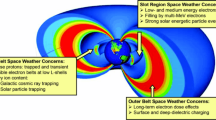Abstract
A stable evening sector are is studied using observations from the FAST satellite at 1250 km altitude and the MIRACLE ground-based network, which contains all-sky cameras, coherent radars (STARE), and magnetometers. Both FAST and STARE observe a northward electric field region of about 200 km width and a field magnitude of about 50 mV/m southward of the arc, which is a typical signature for an evening-sector arc. The field-aligned current determined from FAST electron and magnetometer data are in rather good agreement within the arcs. Outside the arcs, the electron data misses the current carriers of the downward FAC probably because it is mainly carried by electrons of smaller energy than the instrument threshold. Studying the westward propagation speed of small undulations associated with the arc using the all-sky cameras gives a velocity of about 2 km//s. This speed is higher than the background ionospheric plasma speed (about 1 km//s), but it agrees rather well with the idea originally proposed by Davis that the undulations reflect an E × B motion in the acceleration region. The ground magnetograms indicate that the main current flows slightly south of the arc. Computing the ionospheric conductivity from FAST electron data and using the ground magnetograms to estimate the current yields an ionospheric electric field pattern, in rather good agreement with FAST results.
Similar content being viewed by others
Author information
Authors and Affiliations
About this article
Cite this article
Janhunen, P., Olsson, A., Amm, O. et al. Characteristics of a stable are based on FAST and MIRACLE observations. Annales Geophysicae 18, 152–160 (2000). https://doi.org/10.1007/s00585-000-0152-5
Received:
Revised:
Accepted:
Issue Date:
DOI: https://doi.org/10.1007/s00585-000-0152-5




